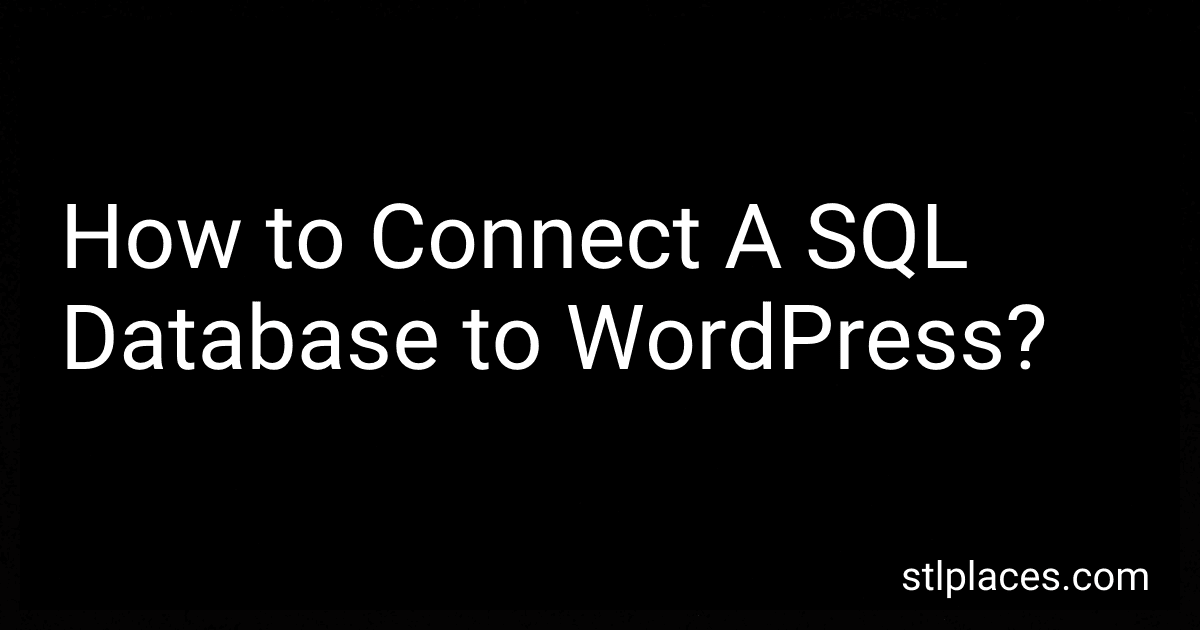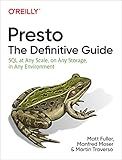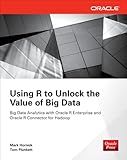Best Database Connection Tools to Buy in December 2025
To connect a SQL database to WordPress, you need to follow these steps:
- Install WordPress: Begin by installing WordPress on your hosting environment or local server. Follow the installation instructions provided by WordPress.
- Access database details: Once WordPress is installed, you will need to access your database details. These details typically include the database name, username, password, and host. You can obtain this information from your hosting provider or by accessing your hosting control panel.
- Edit the wp-config.php file: The wp-config.php file is located in the root directory of your WordPress installation. Open this file using a text editor.
- Define database details: Within the wp-config.php file, locate the section that contains database configuration. It should be labeled "MySQL settings" or similar. Replace the placeholder values with your actual database details. For example, update the 'DB_NAME' field with your database name, 'DB_USER' with your username, 'DB_PASSWORD' with your password, and 'DB_HOST' with your database host.
- Save and upload changes: After making the necessary changes, save the wp-config.php file and upload it back to the root directory of your WordPress installation, replacing the existing file.
- Test the connection: To verify if the connection is successful, open your WordPress website in a web browser. If the connection is established correctly, your website should load normally. If it fails to connect, make sure the database details you provided are correct.
By following these steps, you can effectively connect a SQL database to WordPress and begin utilizing it to store and retrieve your website's data.
What are the common SQL errors encountered while connecting to WordPress?
Some common SQL errors encountered while connecting to WordPress are:
- Error establishing a database connection: This error occurs when WordPress is unable to connect to the database. It can be caused by incorrect database credentials, database server issues, or a corrupt database.
- MySQL server has gone away: This error occurs when the MySQL server drops the connection unexpectedly. It can be caused by large queries or long periods of inactivity.
- Table does not exist: This error occurs when a required table in the WordPress database is missing or has been renamed. It can be caused by a corrupted database or a failed WordPress update.
- Syntax error: This error occurs when there is a syntax error in the SQL query. It can be caused by missing or misplaced brackets, quotation marks, or incorrect table or column names.
- Maximum execution time exceeded: This error occurs when the database query takes too long to execute and exceeds the maximum execution time set by the server. It can be caused by complex queries, large amounts of data, or server configuration issues.
- Out of memory: This error occurs when the server runs out of memory while executing the SQL query. It can be caused by insufficient server resources or inefficient database queries.
- Duplicate entry: This error occurs when trying to insert a record with a primary key that already exists in the database. It can be caused by duplicate data or incorrect primary key settings.
- Locked tables: This error occurs when the tables in the database are locked and cannot be accessed by WordPress. It can be caused by concurrent database operations or a misconfigured server.
- Connection timed out: This error occurs when the database connection takes too long to establish. It can be caused by network issues, incorrect database configuration, or server load.
- Disk full: This error occurs when the server's disk space is full, preventing the database from functioning properly. It can be caused by storing excessive data or lack of server maintenance.
What is the difference between MySQL and SQL databases?
MySQL is a specific implementation of a relational database management system (RDBMS) that uses the SQL (Structured Query Language) language to interact with the database. SQL, on the other hand, is a standard programming language used for managing databases, including defining, manipulating, and querying the data.
In simpler terms, MySQL is the specific software product that allows you to create and manage databases using the SQL language. SQL, on the other hand, is a broader term referring to the language used to interact with databases, and it can be implemented by multiple database systems, not just MySQL.
In summary, MySQL is a specific implementation of an RDBMS that uses SQL as its language, while SQL is a standard language used for managing databases across different systems.
What are the required SQL database connection details for WordPress?
The required SQL database connection details for WordPress are as follows:
- Database Name: The name of the database where WordPress should be installed.
- Username: The username used to connect to the database.
- Password: The password for the database user.
- Database Host: The hostname or IP address of the server where the database is located. This is usually 'localhost' or '127.0.0.1'.
- Table Prefix: The prefix that should be added to all WordPress tables in the database. This is optional, but recommended for security reasons.
These details are typically entered during the WordPress installation process or can be found in the wp-config.php file of an existing WordPress installation.
How to troubleshoot database connection issues in WordPress?
To troubleshoot database connection issues in WordPress, you can follow these steps:
- Check database credentials: Ensure that the database credentials in the WordPress configuration file (wp-config.php) are correct. This includes the database name, username, password, and host.
- Test database connectivity: Use a separate database management tool (such as phpMyAdmin or MySQL command line) to connect to the database using the same credentials as in the wp-config.php file. If the connection fails, it may indicate a problem with the credentials or the database server itself.
- Verify database server availability: Ensure that the database server is running and accessible. Check with your hosting provider or server administrator to confirm that the database server is functioning correctly.
- Check database server logs: Examine the database server logs for any error messages or warnings that could provide clues about the connection issues. Consult your hosting provider or server administrator for assistance in accessing and interpreting these logs.
- Disable plugins or themes: Temporarily deactivate any recently installed plugins or themes that might be interfering with the database connection. You can do this by renaming the plugin or theme directories inside the wp-content folder via FTP or using the WordPress admin dashboard.
- Repair the database tables: If the connection issue is specific to a particular table or set of tables, you can try repairing them. This can be done using the WordPress built-in database repair tool or via a database management tool.
- Increase PHP memory limit: In some cases, low PHP memory limit settings might cause database connection issues. Increase the memory limit by adding the following line to your wp-config.php file: define('WP_MEMORY_LIMIT', '128M'); You can adjust the value as needed.
- Clear database cache: Some caching plugins or services might cache database connections. Clear the database cache to ensure that you're connecting to the correct database.
- Default to a fresh installation: If all else fails, create a new installation of WordPress on the same server or a different server, and see if the database connection works. This can help isolate any server-specific issues.
Always remember to backup your website and database before making any changes or attempting troubleshooting steps. If you're not comfortable with database management or troubleshooting, consider reaching out to a developer or your hosting support for assistance.
How to optimize the WordPress database for better performance?
Optimizing the WordPress database is important for improving the overall performance of your website. Here are some steps you can take to optimize the database:
- Backup your database: Before making any changes, it's crucial to create a backup of your database to avoid any data loss.
- Remove unnecessary data: Delete unnecessary data such as spam comments, trashed posts, post revisions, unused tags, and categories. You can use plugins like WP-Sweep or WP-Optimize to safely remove these data.
- Optimize database tables: Over time, database tables can become fragmented, which slows down the website. Use plugins like WP-Optimize or WP-Sweep to optimize and repair your database tables.
- Limit post revisions: By default, WordPress stores unlimited post revisions. This can increase the database size. Use the 'WP_POST_REVISIONS' constant in your wp-config.php file to limit the number of post revisions stored.
- Disable or limit trash feature: WordPress stores deleted posts, comments, and other items in the trash, which can consume space. You can either disable the trash feature by adding 'define('EMPTY_TRASH_DAYS', 0);' to your wp-config.php file or limit the number of days items remain in the trash before being automatically deleted.
- Use a caching plugin: Utilize a caching plugin like W3 Total Cache or WP Super Cache to optimize your website's performance. These plugins can cache your database queries and reduce the load on the server.
- Optimize images: Large image files can slow down your website. Use an image optimization plugin like Smush or EWWW Image Optimizer to compress and optimize your images, reducing their size without compromising quality.
- Minify CSS and JavaScript files: Minifying these files reduces their size, improves page load times, and lowers server load. You can use plugins like Autoptimize or W3 Total Cache to minify CSS and JavaScript files.
- Regularly update WordPress and plugins: Keeping your WordPress core, theme, and plugins up-to-date ensures you have the latest performance enhancements and security fixes.
- Monitor and optimize database performance: Regularly monitor your website's performance using tools like Google PageSpeed Insights or GTmetrix. If you notice any bottlenecks, you can consider using query optimization techniques or working with a developer to further optimize your database performance.
Remember to always proceed with caution and backup your database before making any major changes to avoid data loss.
What is the purpose of wp-config.php file in WordPress?
The wp-config.php file in WordPress serves as the main configuration file for a WordPress website. Its purpose is to store and define important settings and parameters for the installation, such as:
- Database Connection Settings: It contains the details required to connect WordPress with the database, such as database name, username, password, and host.
- Security Keys: The file includes unique security keys and salts that enhance the security of user sessions and store information in cookies.
- Filesystem Configuration: It allows configuring the method WordPress uses to interact with the server's file system. This includes specifying the file transfer method, setting the default directory for media uploads, and enabling/disabling direct file editing.
- Database Table Prefix: It defines the prefix for all WordPress database tables, providing an added layer of security by making it more difficult for potential attackers to target certain tables.
- Debugging and Error Reporting: The file enables or disables WordPress debugging mode and controls the level of error reporting, which is helpful for troubleshooting and development purposes.
- Custom Settings: Various custom settings can be added to the wp-config.php file, such as defining the website URL, enabling Multisite mode, setting memory limits, modifying cache settings, and more.
Overall, the wp-config.php file is crucial in configuring and customizing the WordPress installation to suit specific requirements, manage security, and control how the website interacts with its database and file system.
How to backup and restore a WordPress database?
To backup and restore a WordPress database, you can follow these steps:
- Backup the WordPress Database: Log in to your WordPress hosting account. Access your hosting control panel or the phpMyAdmin tool provided by your hosting provider. Locate the database associated with your WordPress installation. Select the database and choose the "Export" option. Choose the export method as "Quick" or "Custom" (if you want to modify the export settings) and click on the "Go" button. Save the exported database file (usually in .sql format) to your local computer.
- Restore the WordPress Database: Log in to your hosting account. Access your hosting control panel or phpMyAdmin tool. Locate the database associated with your WordPress installation. Select the database and choose the "Import" option. Click on the "Choose File" button and select the backed-up database file (.sql format) from your local computer. Choose the appropriate import settings, or leave them as default, and click on the "Go" button. Once the import is completed, you will receive a success message confirming the database restoration.
Note: It is important to ensure you have a backup of your WordPress files and any other necessary components along with the database backup, as restoring just the database will not include themes, plugins, media files, etc.
What is the role of wp-db.php in WordPress?
The wp-db.php file in WordPress is responsible for establishing and maintaining the connection between the WordPress application and the database. It contains a class called WPDB, which provides functions for interacting with the database.
The main role of wp-db.php is to handle database queries. It provides methods for executing SQL queries, fetching results, preparing and sanitizing data, and managing the database connection. It also takes care of error handling and logging database errors.
Additionally, the WPDB class in wp-db.php provides functions for performing common database operations such as inserting, updating, and deleting data from database tables. It abstracts the complexity of database operations and offers a standardized way to interact with the database.
In summary, wp-db.php plays a crucial role in WordPress by acting as a bridge between the WordPress application and the database, providing functions and methods for executing SQL queries and managing the database connection.
How to install WordPress?
To install WordPress, follow these steps:
- Choose a hosting provider: Select a hosting provider that supports WordPress installation. Popular options include Bluehost, SiteGround, and HostGator. Compare their pricing plans and features to find the most suitable one for your needs.
- Register a domain: If you don't already have a domain, choose and register one with a reliable domain registrar. Many hosting providers also offer domain registration services.
- Set up hosting: Sign up for a hosting plan with your chosen provider. They will guide you through the process of setting up your hosting account. You will need to provide your personal details, select a plan, and make a payment.
- Access your hosting control panel: Once your hosting account has been activated, you will receive login credentials to access your hosting control panel. This panel may differ depending on the hosting provider, but popular ones include cPanel and Plesk.
- Install WordPress: In your hosting control panel, look for the "WordPress" or "Website" section and click on it. Find the option to install WordPress and follow the provided instructions. You will be asked to enter your domain name and choose a username and password for your WordPress administrator account.
- Customize your site: Once the installation is complete, you can access your WordPress dashboard by entering your domain followed by "/wp-admin" in a web browser (e.g., yourdomain.com/wp-admin). Use your administrator username and password to log in.
- Choose a theme: WordPress provides a wide range of free and premium themes that determine the design and layout of your website. From the WordPress dashboard, go to "Appearance" and then "Themes" to browse and install themes.
- Install plugins: WordPress plugins enhance the functionality of your website. Explore the "Plugins" section in the WordPress dashboard to install and activate relevant plugins for SEO, security, performance optimization, contact forms, and more.
- Customize your website: Customize the appearance and layout of your website using the built-in WordPress customization options or by editing the theme files. You can create pages, menus, and add content to your site.
- Launch your website: When you are satisfied with the design and content of your website, you can now launch it by promoting it to your desired audience. Share it on social media, optimize it for search engines, and start creating valuable content for your visitors.
Remember to regularly update WordPress, your themes, and plugins to ensure security and performance improvements.




